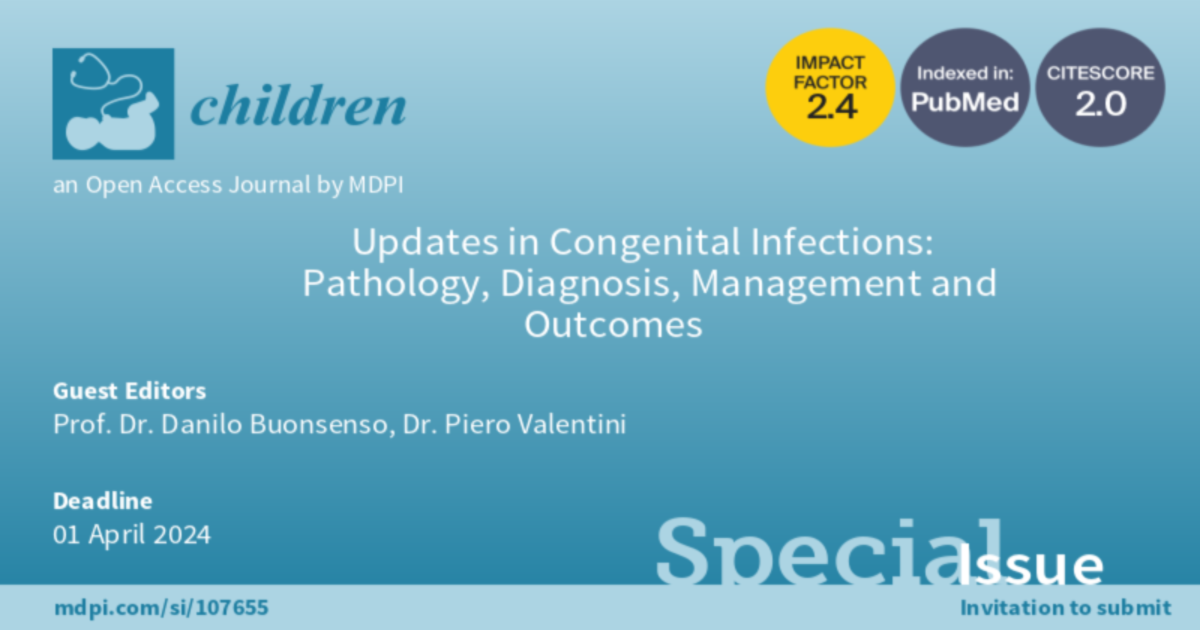Updates in Congenital Infections: Pathology, Diagnosis, Management and Outcomes
A special issue of Children (ISSN 2227-9067). This special issue belongs to the section "Pediatric Infectious Diseases".
Deadline for manuscript submissions: closed (1 April 2024) | Viewed by 27393

Special Issue Editors
Interests: pediatric infectious diseases; global health
Special Issues, Collections and Topics in MDPI journals
Special Issue Information
Dear Colleagues,
Congenital infections still represent a major burden of morbidity and mortality worldwide. Despite several advances made in the understanding of their aetiology, methods for their optimal management and means for the prevention of several groups of infections are still unknown. Moreover, SARS-CoV-2 has been added to the list of known agents able to infect pregnant women and cross the placenta, causing vertical infections.
The aim of this Special Issue is to link expert and young researchers in the field to share updated perspectives on congenital infections. We are interested in studies discussing epidemiology, diagnostics, and clinical and management implications, as well as social issues related to the topic (including, but not limited to, socially fragile populations).
Dr. Danilo Buonsenso
Dr. Piero Valentini
Guest Editors
Manuscript Submission Information
Manuscripts should be submitted online at www.mdpi.com by registering and logging in to this website. Once you are registered, click here to go to the submission form. Manuscripts can be submitted until the deadline. All submissions that pass pre-check are peer-reviewed. Accepted papers will be published continuously in the journal (as soon as accepted) and will be listed together on the special issue website. Research articles, review articles as well as short communications are invited. For planned papers, a title and short abstract (about 100 words) can be sent to the Editorial Office for announcement on this website.
Submitted manuscripts should not have been published previously, nor be under consideration for publication elsewhere (except conference proceedings papers). All manuscripts are thoroughly refereed through a single-blind peer-review process. A guide for authors and other relevant information for submission of manuscripts is available on the Instructions for Authors page. Children is an international peer-reviewed open access monthly journal published by MDPI.
Please visit the Instructions for Authors page before submitting a manuscript. The Article Processing Charge (APC) for publication in this open access journal is 2400 CHF (Swiss Francs). Submitted papers should be well formatted and use good English. Authors may use MDPI's English editing service prior to publication or during author revisions.
Keywords
- congenital infections
- pregnant women
- newborns
- SARS-CoV-2
- infections
Benefits of Publishing in a Special Issue
- Ease of navigation: Grouping papers by topic helps scholars navigate broad scope journals more efficiently.
- Greater discoverability: Special Issues support the reach and impact of scientific research. Articles in Special Issues are more discoverable and cited more frequently.
- Expansion of research network: Special Issues facilitate connections among authors, fostering scientific collaborations.
- External promotion: Articles in Special Issues are often promoted through the journal's social media, increasing their visibility.
- Reprint: MDPI Books provides the opportunity to republish successful Special Issues in book format, both online and in print.
Further information on MDPI's Special Issue policies can be found here.







